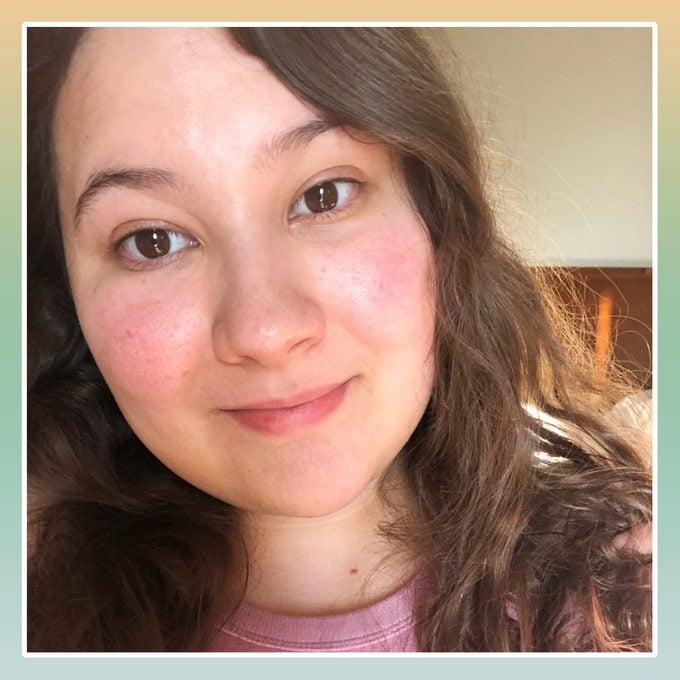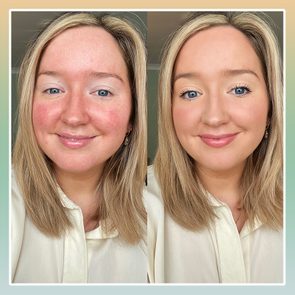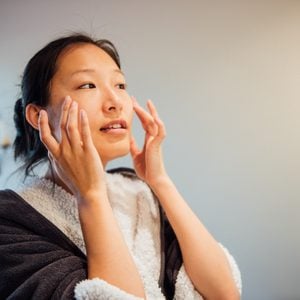A Rosacea Diagnosis Inspired Me to Find the Best Skin Care Products
Updated: Nov. 24, 2020
After a surprising rosacea diagnosis, a skin care blogger shares how she combats the symptoms with her own rosacea skin care routine, including the right moisturizers, creams, and cleansers.
Our editors and experts handpick every product we feature. We may earn a commission from your purchases.

Managing rosacea
In general, experts recommend that you see a dermatologist at least once a year—although that often doesn’t happen. That’s one reason that common skin conditions like rosacea can go undiagnosed. Or, like in Trish Valencia’s case, they can be diagnosed in surprising ways. Valencia, an Arizona-based skin care blogger, explains how she discovered she had rosacea. After her diagnosis, she found out how to combat the symptoms by avoiding triggers, nourishing her skin, and following a specific rosacea skin care routine.
A makeup counter discovery of rosacea
When I was 22, I was at a Clinique counter at the mall getting my face shade-matched for foundation. The consultant took off the foundation I was wearing and told me that she couldn’t diagnose me, but that she was “99 percent sure” that I had rosacea. Makeup consultants look at people’s skin all day, every day, so even though she wasn’t a doctor I was inclined to believe her.
In fact, the persistent redness on my cheeks and chin was the primary reason I was there in her chair. I heard about a new color correcting makeup line and was hoping it would help hide my redness.
At the time, I didn’t know anything about rosacea. I knew my face was red, so I rarely ever left the house without taking the time to put on foundation. But my main concern was always trying to cover it up, never trying to improve or heal it. (Read more about makeup tricks for rosacea.)
A confirmed rosacea diagnosis
After my encounter at the beauty counter, I dove headfirst into researching skin care. I discovered Hyram (a skin care enthusiast) and Dr. Dray (a dermatologist) on YouTube. Soon after, I realized that the products I was using may not have been suitable for my skin type. But first, I wanted to make sure I did, in fact, have rosacea.
I went to see a dermatologist and he diagnosed me with subtype 1 rosacea, also known as erythematotelangiectatic rosacea, which causes persistent redness on the nose, cheeks, forehead, and chin. During my dermatologist checkup, he prescribed doxycycline for my rosacea symptoms—an antibiotic that’s used for pimples and abscesses. This is also known as acne rosacea.
My doctor told me that it would make my skin more sensitive to the sun and that he couldn’t be sure if it would help my redness or worsen it. It was also unclear whether it would react poorly with the birth control I was taking at the time. (He said it wouldn’t, but the pharmacist said it would.)
I decided to opt out and not take it because I felt like the risks outweighed the benefits. We also discussed laser treatment, which is a procedure that I’ve heard can work well for rosacea. I’m definitely interested in down the road, though I haven’t pursued it yet.
Learning about rosacea skin care
In the meantime, I decided to focus on my research and work to craft the skin care routine that was best for me. I learned that if you have rosacea, you may not be able to tolerate as much in your products as someone with normal, healthy skin because the skin barrier is compromised. I learned that most people with rosacea should avoid fragrances, essential oils, and over-exfoliation, but a lot of it is trial and error.
In addition to my favorite YouTubers, I followed a lot of dermatologists, cosmetic chemists, and formulators on social media. Their posts taught me how to spot different fragrances and chemical exfoliants on ingredient lists and the different names they may have, plus other ingredients to look for or avoid in skin care products.
My rosacea skin care routine
In the morning, I cleanse my face with just water, then I use a lightweight fragrance-free moisturizer and a mineral SPF. My favorite moisturizers are CeraVe Daily Moisturizing Lotion, which helps strengthen the skin barrier, and PROcure Rosacare HydroGel, a green moisturizer that helps color correct redness.
I make sure to reapply SPF every two hours while the sun is up to ensure I’m getting adequate protection.
Then at night, I use a double cleansing method with a fragrance-free oil balm, a gentle cleanser—my favorite is Vanicream Gentle Facial Cleanser—and moisturizer.
Sometimes I incorporate azelaic acid to gently exfoliate and help with the redness and inflammation or use Krave Beauty Great Barrier Relief to soothe my skin if it’s feeling irritated. And I love trying new products that pass my ingredient check and sharing those with my Instagram followers.
Identifying rosacea triggers
I think that one of the most important things anyone who has rosacea can do is identify their triggers. The more you trigger your rosacea, the more you’re causing your blood vessels in your face to dilate, increasing the permanence and severity of your symptoms.
And although it sometimes feels like almost everything is a trigger for rosacea, I do my best to control what I can.
My biggest trigger is an increase in temperature, whether from exercising, taking a hot shower, sipping a hot drink, or being outside on a hot and sunny day. (Here are foods that can be rosacea triggers.)
So when I work out, I always have a cold water bottle and a fan with me. I no longer wash my face in the shower with really hot water; I use lukewarm or cool water instead. I wait for my hot teas to cool down before I drink them and I always wear mineral sunscreen and try not to let the sun shine directly on my face when I’m outside.
I’ve noticed that stress causes a rise in my internal temperature, which can also contribute to flare-ups. And I’m currently in the process of making an Excel spreadsheet to monitor my exposures and try to narrow down what other triggers I may have.
A new outlook on self-care
Before I was diagnosed with rosacea, I always thought of self-care as something that was about indulgence, about doing things that make you feel good in the short term.
But since identifying my triggers and developing my skin care routine, that definition has shifted for me. Now, self-care is about being disciplined and doing things that I know I will thank myself for in the long term.
My skin care routine is something I look forward to every morning and evening, and I feel like making conscious choices to take care of my body’s specific needs, whether in regards to my rosacea or other things, is a great way to show myself some self-love.
Next, learn about home remedies for rosacea.



